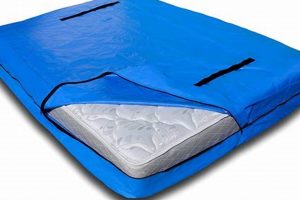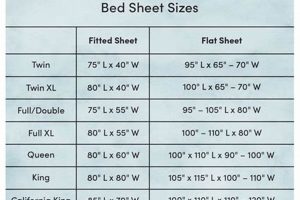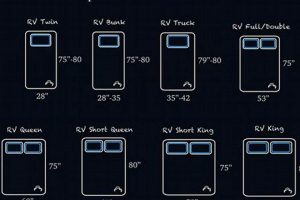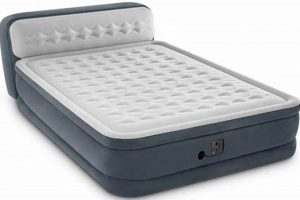Daybeds, versatile pieces of furniture, often require a specialized bedding configuration. These mattresses are specifically dimensioned to fit the frame of a daybed, offering support and comfort whether the daybed is used for seating, lounging, or sleeping. For instance, a standard option typically measures 39 inches wide and 75 inches long, mirroring the dimensions of a twin-size bed, ensuring compatibility with readily available bedding accessories.
The appropriately dimensioned bedding for a daybed maximizes both its aesthetic appeal and functional utility. A well-fitting mattress contributes to the overall design of the room, while providing optimal comfort for users. Historically, daybeds have served diverse purposes, from informal seating areas to sleeping arrangements for guests. The corresponding mattresses have evolved to meet these varying needs, balancing aesthetics with practicality.
Therefore, understanding the relevant measurements of daybed bedding is crucial before purchasing. The subsequent discussion will delve into factors influencing these dimensions, including frame variations, material considerations, and considerations for selecting the ideal dimensions based on intended use.
Selecting the Ideal Daybed Mattress Dimensions
Proper selection hinges on understanding key considerations. Factors include frame type, intended use, and personal preferences regarding firmness and material.
Tip 1: Measure the Daybed Frame Accurately: Prior to purchasing, meticulously measure the interior dimensions of the daybed frame. Account for any internal rails or supports that may impact available space. Inaccurate measurements can result in a mattress that is either too large to fit or too small, creating unsightly gaps.
Tip 2: Consider Intended Use: Determine the primary function of the daybed. If primarily used for seating or lounging, a thicker, firmer mattress may be preferred for support. If frequently used for sleeping, prioritize comfort and consider a mattress with enhanced pressure relief.
Tip 3: Evaluate Mattress Material Options: Common materials include innerspring, memory foam, and latex. Innerspring mattresses offer traditional support and affordability. Memory foam conforms to the body, providing pressure relief. Latex offers a balance of support and responsiveness, with potential hypoallergenic benefits.
Tip 4: Account for Bedding: When selecting dimensions, consider the thickness of bedding, such as sheets and mattress protectors. Excessively thick bedding can compress a mattress, altering its feel and potentially impacting its longevity.
Tip 5: Research Mattress Height: Daybeds often have a trundle option or specific design considerations that dictate optimal mattress height. Select a mattress height that complements the frame design and ensures comfortable access and egress.
Tip 6: Prioritize Edge Support: Adequate edge support prevents sagging and increases the usable surface area of the mattress, particularly important if the daybed is frequently used for seating.
Tip 7: Read Reviews: Before committing to a purchase, consult online reviews from other consumers. Pay particular attention to comments regarding comfort, durability, and fit within specific daybed frames.
Careful consideration of frame dimensions, intended use, material properties, and height restrictions will help in selecting a well-suited mattress.
The following sections will explore specific dimensions and their impact on overall comfort and functionality.
1. Width dimensions
Width, a critical component of overall dimensions, directly influences the usability and comfort of a daybed. The specified width must align with the frame’s internal measurements to ensure proper fit and prevent instability.
- Standard Twin Equivalence
The standard width closely mirrors that of a twin bed, typically 39 inches. This standardization facilitates the use of readily available bedding, such as sheets, comforters, and mattress protectors. Deviation from this width necessitates custom-sized bedding, increasing cost and limiting options. In practical applications, a 39-inch width accommodates a single adult sleeper or provides ample seating space for multiple individuals.
- Frame Design Constraints
Variations in frame design, including the presence of side rails or internal supports, may slightly reduce the available width for the mattress. Accurate measurement of the internal frame dimensions is crucial before selecting. A discrepancy, even as small as an inch, can prevent proper installation and compromise structural integrity. Some daybed frames are designed to accommodate slightly narrower mattresses, offering a more streamlined appearance at the expense of usable surface area.
- Impact on Seating Comfort
The width impacts the comfort when the daybed is used primarily for seating. A wider surface allows for more flexible positioning and reduces crowding. Conversely, a narrower mattress can restrict movement and limit the number of individuals who can comfortably occupy the space. The overall effect depends on the presence of additional cushions and the intended use of the daybed. For example, a daybed intended for lounging may benefit from a wider mattress, while a daybed used primarily for sleeping may prioritize length over width.
- Aesthetic Considerations
While functionality is paramount, width also influences the aesthetic appeal. A mattress that is too narrow creates a visual gap between the mattress and the frame, detracting from the overall design. Conversely, a mattress that is too wide may protrude beyond the frame, creating an unkempt appearance. Striking a balance between fit and aesthetics is essential for achieving a cohesive and visually pleasing design.
In conclusion, the width dimensions of bedding are intrinsically linked to its functionality, aesthetic appeal, and overall compatibility. Selecting a mattress with the appropriate width is crucial for maximizing usability, ensuring structural integrity, and achieving a cohesive design. Careful consideration of frame dimensions, intended use, and aesthetic preferences will facilitate the selection of a mattress with the ideal width. In essence, the selection of a mattress for a size daybed mattress is about finding a harmonious intersection of form, function, and personal style.
2. Length consistency
Length consistency, a fundamental aspect of a appropriately dimensioned daybed mattress, directly affects usability, comfort, and overall aesthetic appeal. Inconsistency in length, relative to the daybed frame’s specifications, introduces several potential problems. A mattress that is too short leaves an unsightly and potentially hazardous gap. A mattress that is too long may buckle or compress, reducing its lifespan and undermining support. Therefore, adherence to established length standards is paramount for both functionality and longevity.
The standard length mirrors that of a twin-size bed, generally 75 inches. This standardization allows for the use of widely available bedding and ensures compatibility with a range of daybed frame designs. Deviation from this standard necessitates custom-made bedding, increasing costs and limiting consumer choice. Moreover, variations in length can disrupt the aesthetic balance of the daybed, creating a disproportionate appearance that detracts from the room’s overall design. For example, a daybed intended for guest accommodation with a shortened mattress may provide inadequate leg support for taller individuals, rendering it unsuitable for overnight use. This illustrates the practical significance of maintaining length consistency.
In summary, length consistency within daybed mattresses is not merely a matter of dimensional accuracy; it is integral to the bed’s functionality, user comfort, and aesthetic cohesion. Challenges arise when dealing with non-standard or antique frames, requiring careful measurement and potentially custom solutions. However, the overarching principle remains: consistent length relative to established standards optimizes the user experience and preserves the intended design of the daybed.
3. Thickness variation
Thickness variation in bedding significantly influences its performance, comfort, and suitability for specific daybed designs. The thickness dimension directly affects the level of support, pressure distribution, and overall comfort. Moreover, thickness considerations are intrinsically linked to the daybed frame design, particularly when a trundle is involved. For instance, a thicker mattress may provide superior cushioning for sleeping but might prevent the trundle from closing properly when stowed. Conversely, a thinner mattress could lack adequate support, leading to discomfort and potential musculoskeletal issues. The selection, therefore, requires careful evaluation of intended use, frame constraints, and personal preferences regarding firmness and support.
Consideration must also be given to long-term durability. A mattress with insufficient thickness may experience accelerated wear and tear, particularly under consistent use. This is especially pertinent in daybeds used both for seating and sleeping. The materials used in mattress construction also play a crucial role. High-density foams or robust innerspring systems can compensate for reduced thickness by providing enhanced support and longevity. Conversely, lower-density materials may compress over time, leading to reduced support and diminished comfort. In real-world scenarios, guest rooms equipped with daybeds require mattresses that strike a balance between comfort, durability, and dimensional compatibility to accommodate a wide range of users.
In conclusion, thickness variation is a critical determinant of overall performance and suitability. The challenges arise in balancing comfort, support, and compatibility with the daybed frame. Careful attention to these factors will ensure the optimal selection, maximizing user satisfaction and prolonging the lifespan. The thickness must correspond with the overall design to maintain its functionality and longevity.
4. Frame compatibility
Frame compatibility, a critical determinant in bedding selection, directly impacts functionality and longevity. The intended bedding must align precisely with the daybed frame’s internal dimensions. Discrepancies result in compromised support, reduced comfort, and potential damage to both the mattress and the frame. This alignment is not merely about physical fit; it influences structural integrity and aesthetic appeal. A standard daybed frame, engineered for a twin-size mattress, requires bedding conforming to those specific dimensions. Failure to adhere to these specifications compromises the integrity of the system, leading to premature wear and potential instability.
Practical implications extend beyond structural concerns. In cases of inadequate frame compatibility, gaps emerge between the mattress and frame, creating potential hazards. These gaps can trap small objects, create uneven sleeping surfaces, and diminish the overall aesthetic. A mattress that is too large, conversely, may buckle under pressure, reducing its support and potentially damaging the frame. The availability of properly dimensioned bedding accessories, such as sheets and mattress protectors, also depends on selecting a mattress that conforms to standard frame specifications. Custom-sized bedding, while an option, often entails significant additional cost and limits consumer choice.
In conclusion, frame compatibility constitutes an essential component of beddings, ensuring both structural integrity and aesthetic cohesion. Challenges in achieving perfect compatibility often arise with antique or custom-built frames, necessitating careful measurement and, potentially, custom bedding solutions. The key takeaway is clear: bedding must seamlessly integrate with the frame to achieve optimal performance, longevity, and user satisfaction. The consequence of ignoring frame compatibility often results in dissatisfaction with bedding.
5. Trundle clearance
Trundle clearance, the available vertical space beneath a daybed frame for stowing a secondary mattress, directly dictates the permissible height dimension of the primary bedding. This space constraint necessitates careful consideration of mattress thickness to ensure seamless operation of the trundle mechanism.
- Mattress Height Restriction
The primary constraint imposed by trundle clearance involves the maximum height of the main mattress. Exceeding this limit prevents the trundle from retracting fully, impeding its functionality. Frame manufacturers typically specify a maximum mattress height, often ranging from 8 to 10 inches, to accommodate the trundle when stowed. Deviation from this specification results in operational failure.
- Impact on Mattress Material Selection
Trundle clearance influences the choice of materials. Thicker mattresses necessitate denser materials to provide adequate support within the height constraint. For instance, a memory foam mattress, known for its conforming properties, may require a higher density to achieve the necessary support in a thinner profile, impacting both cost and comfort.
- Compromises in Comfort and Support
The restriction imposed by trundle clearance can lead to compromises in comfort and support. A thinner mattress may lack the necessary layers to provide optimal pressure relief and spinal alignment, potentially resulting in discomfort or disrupted sleep. Striking a balance between trundle compatibility and sleeping comfort presents a design challenge.
- Frame Design Variations
Trundle clearance varies significantly among daybed frame designs. Some frames incorporate deeper recesses to accommodate thicker mattresses, while others prioritize a lower profile, limiting mattress height. Evaluating frame specifications is crucial before selecting bedding to ensure seamless integration and prevent operational issues.
The interplay between trundle clearance and mattress dimensions requires a holistic approach to bedding selection. Prioritizing trundle functionality without sacrificing comfort necessitates careful consideration of material properties, mattress construction, and frame specifications. This ensures that the size daybed mattress functions as intended.
6. Sleeping comfort
Sleeping comfort, a primary consideration in bedding selection, is inextricably linked to the dimensions of the mattress, particularly in the context of a daybed. The dimensions directly influence the support, pressure distribution, and overall user experience.
- Dimensional Suitability
The dimensions must align with the physical constraints of the daybed frame to ensure optimal sleeping comfort. Inadequate length can lead to insufficient leg support, while insufficient width restricts movement during sleep. A mattress that is either too large or too small compromises support and potentially causes discomfort.
- Thickness and Support
The thickness contributes significantly to the support. A thinner mattress may lack adequate cushioning for pressure relief, potentially causing discomfort or exacerbating existing musculoskeletal issues. Conversely, an excessively thick mattress, while providing ample cushioning, may compromise spinal alignment. The ideal thickness balances support and pressure relief.
- Material Composition
The material properties directly impact the sleeping comfort. Memory foam conforms to the body, providing pressure relief but potentially trapping heat. Innerspring mattresses offer traditional support and breathability but may lack contouring. Latex offers a balance of support and responsiveness. The choice of material depends on individual preferences and specific needs.
- Edge Support
Adequate edge support prevents sagging and maximizes the usable surface area. A mattress with weak edge support may cause sleepers to feel as though they are rolling off the edge, compromising sleeping comfort and stability. Strong edge support is particularly important in daybeds, which often serve dual roles as seating areas.
The sleeping comfort is determined by the dimensions and materials of the mattress. Careful selection is crucial for ensuring a restful and restorative sleep experience. Considerations of size daybed mattress’ dimensions are pivotal to achieving optimal sleep quality and overall satisfaction.
7. Seating support
The capacity of bedding to provide adequate seating support is a direct function of its dimensions, construction, and material properties. The edges of the mattress are subject to concentrated loads when used for seating, leading to potential deformation or collapse if inadequately supported. This structural integrity directly impacts the long-term viability and usability as both a seating and sleeping surface. The overall dimensions, especially width and thickness, influence weight distribution and the degree of support provided to seated individuals. For instance, a thinner mattress with inadequate edge support may cause discomfort and instability, particularly for extended periods of seating.
Conversely, a size daybed mattress with reinforced edges and appropriate thickness can distribute weight more evenly, maintaining its shape and providing enhanced comfort. The choice of internal materials, such as high-density foam or reinforced spring systems, plays a critical role in determining the mattress’s capacity to withstand prolonged seating use. Real-world applications demonstrate that reinforced edge support is particularly important in daybeds used frequently in living rooms or guest rooms, where they serve as primary seating areas. Without adequate support, the edges may sag over time, diminishing the overall aesthetic and compromising the mattress’s intended function.
In summary, seating support within a size daybed mattress is a function of specific dimensions and material selections, ensuring structural integrity and comfortable support. The challenge lies in balancing sleeping comfort with seating support, often requiring specialized construction techniques. The ultimate goal is a dual-purpose solution that effectively serves both seating and sleeping needs, thereby maximizing the daybed’s utility and lifespan. Prioritizing seating support alongside other considerations will ensure that the chosen mattress delivers both long-term durability and optimal user satisfaction.
Frequently Asked Questions Regarding Bedding Dimensions
The following addresses common inquiries concerning the specific dimensions for a size daybed mattress and its implications for comfort, functionality, and suitability.
Question 1: What are the standard measurements?
The standard measurements typically align with those of a twin-size bed, specifically 39 inches wide and 75 inches long. These dimensions ensure compatibility with widely available bedding and allow for comfortable accommodation of a single adult.
Question 2: How does mattress thickness affect trundle functionality?
Thickness directly influences whether a trundle can fully retract beneath the frame. A mattress exceeding the manufacturer’s specified thickness will obstruct the trundle’s movement, rendering it non-functional. Prioritize height limitations when selecting a mattress for a daybed with a trundle.
Question 3: What happens if a mattress is too short for the frame?
A mattress that is too short for the frame creates unsightly and potentially hazardous gaps. These gaps may trap objects, diminish the overall aesthetic, and compromise support. Accurate measurement of the frame’s internal dimensions is crucial to avoid this issue.
Question 4: Does the mattress composition impact seating support?
Material composition plays a pivotal role in determining seating support. Mattresses with reinforced edges and high-density foam provide superior support and prevent sagging during prolonged seating use. Innerspring mattresses may offer less consistent support across the surface.
Question 5: How does mattress width affect comfort?
Width significantly impacts sleeping and seating comfort. A wider mattress allows for greater freedom of movement during sleep and reduces crowding when used for seating. The ideal width balances functionality and space efficiency.
Question 6: What considerations are necessary for custom frames?
Custom frames may necessitate custom-sized bedding, as standard dimensions may not apply. Accurate measurement of the frame’s internal dimensions is essential, and consultation with a bedding specialist is recommended to ensure proper fit and functionality.
In summary, careful consideration of dimensions, material composition, and frame specifications is crucial for selecting a bedding that optimizes comfort, functionality, and longevity.
The following section will delve into common misconceptions surrounding bedding and its proper utilization.
Conclusion
This exploration has underscored the critical importance of dimensions for a size daybed mattress in determining functionality, comfort, and longevity. Consideration of width, length, and thickness, coupled with an understanding of frame compatibility and trundle clearance, forms the bedrock of informed decision-making. Material composition and edge support further contribute to the overall suitability of the chosen bedding.
The presented information serves as a definitive resource for those seeking to optimize their daybed experience. Adherence to these principles ensures not only a comfortable and aesthetically pleasing addition to any living space but also a durable and reliable investment for the future. Prioritizing these factors represents a commitment to both quality and functionality in selecting the optimal bedding solution.




![Best Hybrid Queen Mattress [Year]: Comfort & Support Organic & Natural Mattress Buyer’s Guide: Non-Toxic Sleep Solutions Best Hybrid Queen Mattress [Year]: Comfort & Support | Organic & Natural Mattress Buyer’s Guide: Non-Toxic Sleep Solutions](https://mattressworldpa.com/wp-content/uploads/2025/07/th-2259-300x200.jpg)


